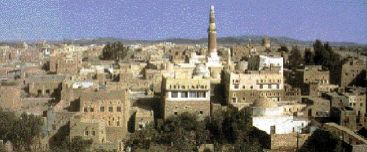
Saadah, Outstanding Historical & Archeological Heritage [Archives:2001/02/Last Page]
January 8 2001

Saadah flat land (Qaa):
The flatlands of Saadah are amongst the most fertile in Yemen with farmers growing black grapes, pomegranate, peaches, apricots, figs and other fruits at high altitudes (1800 meters above sea level), one of the highest flatlands in Yemen. The area is enclosed by Jumaa and Ghamar mountains from the north and west and Sahar mountains from the south, while from the east, there are the Hamdan mountains.
Eastern Saadah:
High mountains and desert characterize this part of the governorate, with a number of valley streams flowing through to the Empty Quarter Desert.
Climate:
The climate of Saadah is generally moderate in summer with the temperature ranging from 16-26 degrees C and cold during winter with temperatures ranging from 16-0 degrees C during the night and early morning.
Population activities:
Most of the inhabitants of Saadah are engaged in agriculture and raising livestock with a minority working as craftsmen and traders.
Handicrafts:
Saadah is famous for its good-quality iron, traces of which can be seen in various parts of the governorate. Some of its people still work in the mining of iron-ore from the mountains. They melt it in primitive furnaces to make tools, due to its high-quality, and despite the availability of imported iron in the markets. Dagger blades from Saadah were sought after. The iron is also used in the manufacture of ploughs and leather tanning tools. Other handicrafts include: leather goods and ornaments. Saadah is an important center for silver jewelry. Saadah is also famous for domestic utensils made from palm leaves and clay. The residents of Saadah are very skillful in the making of kitchen-ware from stone extracted from the Razeh quarries. Such stones are called Harradh and the utensils made from these stones are very popular and called al-Maqla al-Sadi, al-Hardha al-Sadiyya meaning Saadah frying pan.
Markets:
There are a number of weekly markets held in different parts of the governorate on different days, the most important being al-Talh, 10 km to the north of Saadah, which is held every Saturday and is one of the biggest markets in Yemen.
Architectural style:
Saadah architecture is unique to the city and the surrounding area and is dominated by the adobe structures. Al-Hadi mosque, dates back to the 9th century, is one of the oldest and most beautiful mosques in Yemen. It contains tombs and domes, the most important of which is the tomb of al-Hadi Yahia Bin al-Hussain, founder of the al-Zaidi dynasty in the 9th century. Al-Hadi and other mosques in Saadah are used for theological studies, which give the city an academic aura comparable to that of Sanaa, Zabid, Tarim, Dhamar and Djibla. In the mosque there are several references talking about the history of the region and Islam.
Saadah Muslim graveyard, located close to the citys gate, is unique in that the stones are engraved with the names of the deceased, the date of death, his virtues, prayers and verses from the holy Quraan and sometimes some poetry.
Surrounding area:
Scattered around Saadah and in parts of Qaa al-Sahn and Saeed Qaa Saadah there are beautiful villages with the same architectural patterns as Saadah and are rich in grape-vines, gardens, pomegranate and other fruits. Worthy of a special mention are the villages of al-Talh, al-Abdeen and Rahban.
Rock Drawings and Primitive Paintings:
Saadah is an area which boasts a large collection of ancient paintings and signs dating back to the Hunter Gathers Society. In the mountain area many of the caves and rocks are full of inscriptions and paintings of goats, hounds, cows, snakes, plant and geometrical shapes. The two areas, rich in such drawings and paintings, are Al-Khazain, 15 kms to the north-west of Saadah at Om Laila and Musalhaqat 5 kms further on.
Al-Khazain, Rocky Graveyards:
Fifteen km to the north-west of Saadah is the Rocky Graveyard. This graveyard is carved in the mountain and resembles a vault. It has a square door leading to rooms, each about 20 square meters. The rooms are similar to those at Shiban Kawkaban, Dhafar al-Malik, Wadi Dhafar and Shibam al-Gharras. At al-Khazain there is a reservoir eight meters deep and 4 meters wide.
Other places worth visiting are Haidan, Baqim, Wadi Nashur, Razeh, Saqin, Waela, Sahar, Ghuraz and Al-Buqaa.
Customs, Traditions and Folklore
Saadah is rich in its art, folklore dances and music, with some of its residents having traditions found nowhere else. For example, the male residents on the outskirts of Saadah wear wreaths of flowers around their heads and their hair is grown down to their shoulders. This part of Saadah has retained a life-style which has not been affected in time.
Al-Buqaa, a crossing point for Saudi Arabia, is located to the north-east of Saadah.
Forts and Castles of Saadah:
Saadah has always been an important point on the trade route: the frankincense camel cravens from the Asad rout, or the proprietors of the elephant route which passed by a series of towns and hills during the pre-Islamic era, and is also a route for pilgrims during Islam. The construction of forts and castles, therefore, seemed necessary to protect the travelers. Some were built close to Saadah such as al-Sinarah, Samaa fort, Tulmus fort and Alba fort. The most important of the forts and castles is Om Laila, located 60 kms to the north-west of Saadah at Baqim and Jumaah.
——
[archive-e:02-v:2001-y:2001-d:2001-01-08-p:./2001/iss02/lastpage.htm]


